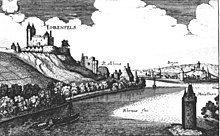Ehrenfels Castle (Hesse)
| Ehrenfels Castle | ||
|---|---|---|
|
Ehrenfels castle ruins as seen from the Rhine, south-east view |
||
| Creation time : | around 1210 | |
| Castle type : | Höhenburg, hillside location | |
| Conservation status: | ruin | |
| Standing position : | Unknown assignment | |
| Place: | Rudesheim am Rhein | |
| Geographical location | 49 ° 58 '31 " N , 7 ° 52' 50" E | |
|
|
||
The Ehrenfels Castle is the ruins of a hillside castle west of Rudesheim am Rhein halfway to Assmannshausen in the Rheingau-Taunus-Kreis in Hesse . It stands on the northeast bank of the Rhine on the steep slope of the Rüdesheimer Berg , which includes several of the best vineyards in Germany.
The 4.6-meter-thick, 20-meter-high shield wall with its two 33-meter-high corner towers as well as the remains of the palace and a gate building have been preserved from the former 600 square meter customs castle .
Ehrenfels Castle has been part of the Upper Middle Rhine Valley UNESCO World Heritage Site since 2002 .
description
On the north side (mountain side) is the shield wall with its two round corner towers in the west and east. This wall, the remains of a building in the west, the three-storey palace on the south side (Rhine side) and the circular wall in the east delimit an inner courtyard with a cistern . Access was once from the east through the outer bailey with a gate . Only the foundations of these buildings in the outer bailey are visible.
The kennel was located below the hall .
history
The Archbishopric of Mainz was attacked by Count Palatine Heinrich I during the dispute between Philip of Swabia and the son of Heinrich the Lion , Otto , over the imperial crown of the Holy Roman Empire . Ehrenfels Castle was then possibly built around 1211 by Philipp von Bolanden on behalf of Archbishop Siegfried II von Eppstein in response to this attack.
Although Philipp von Bolanden built the castle with his own resources, the Archdiocese of Mainz laid claim to it when his widow Beatrix Dietrich von Heinsberg married. In 1222 the castle was closed to Mainz by a royal judgment. It was occupied by the Electorate of Mainz and became a customs post towards the middle of the 13th century. The actual customs office was on the river and was connected to the Binger mouse tower .
In 1301 the castle was handed over to Archbishop Gerhard II of Eppstein during the Rhenish Customs War of the Electors against King Albrecht and to Gottfried von Brauneck for five years after Albrecht's victory. Monastery administrator Kuno II von Falkenstein expanded the complex after it was pledged to him in the second Mainz monastery feud in 1353 . Archbishop Gerlach von Nassau tried to dissolve the pledge by claiming that Kuno wanted to have him murdered and in 1356 occupied the castle.
The Niederwald , as can be seen from forest reports from 1587/88, as well as a feudal courtyard at the site of the later Niederwald hunting lodge , were connected to the castle as a commercial forest .
During the Thirty Years' War the castle was besieged several times and occupied by various warring factions.
There are two theories about the desolation of the castle. One says that Archbishop Anselm Casimir Wambolt von Umstadt had the castle burned down in 1636 to prevent it from serving as a hideout. What is certain, however, is that the complex was badly damaged in 1689 by the army of French Marshal Nicolas Chalon du Blé , Marquis d'Huxelles, during the War of the Palatinate Succession . The outer castle complexes were removed when further vineyards were created. The ruin was given up by the Mainz cathedral chapter and the Niederwald was for sale. In 1693 it was owned by the Counts of Stadion. In the same year parts of the property and then again in 1705 the rest of the property went to Johann Franz Sebastian von Ostein .
The castle, which fell to Prussia in 1866 , is now owned by the State of Hesse. The castle courtyard is locked with bars so that a tour of the interior is not possible.
Events
Rhine in flames on the 1st Saturday in July: large fireworks and boat tour on the Middle Rhine from Trechtingshausen with Reichenstein Castle , along Rheinstein Castle , Assmannshausen, Binger Mäuseturm, ruins of Ehrenfels Castle (Hesse), Bingen am Rhein with Klopp Castle to Rüdesheim am Rhein with the Brömserburg .
literature
- Thomas Biller, Achim Wendt: Castles in the Upper Middle Rhine Valley World Heritage Area - A Guide to Architecture and History . 1st edition. Schnell & Steiner, Regensburg 2013, ISBN 978-3-7954-2446-6 , pp. 78–82.
- Thomas Biller: Castles in the Taunus and in the Rheingau - A guide to history and architecture 1st edition. Schnell & Steiner publishing house, Regensburg 2008, ISBN 3-7954-1991-3 , pp. 87-91.
- Rudolf Knappe: Medieval castles in Hessen. 800 castles, castle ruins and fortifications. 3. Edition. Wartberg-Verlag, Gudensberg-Gleichen 2000, ISBN 3-86134-228-6 , pp. 468-469.
- Otto Piper : Castle studies. Construction and history of the castles initially within the German-speaking area . Reprint of the 1912 edition of Piper & Co-Verlag. Weltbild, Augsburg 1994, ISBN 3-89350-554-7 , pp. 266-267.
- Rolf Müller (Ed.): Palaces, castles, old walls. Published by the Hessendienst der Staatskanzlei, Wiesbaden 1990, ISBN 3-89214-017-0 , p. 305f.
Web links
- Ehrenfels Castle in the Rheingau
- monument preservation hessen: Ehrenfels Castle
- Ehrenfels Castle, Rheingau-Taunus District. Historical local dictionary for Hessen. In: Landesgeschichtliches Informationssystem Hessen (LAGIS).
- Entry by Hans-Jürgen Hessel zu Ehrenfels in the scientific database " EBIDAT " of the European Castle Institute
- Ehrenfels Castle on the Burgenwelt.org site
Individual evidence
- ^ Friedrich-Wilhelm Krahe: Castles of the German Middle Ages. Floor plan lexicon. Augsburg, Bechtermünz-Verlag 1996, ISBN 3-86047-219-4 , p. 165.







